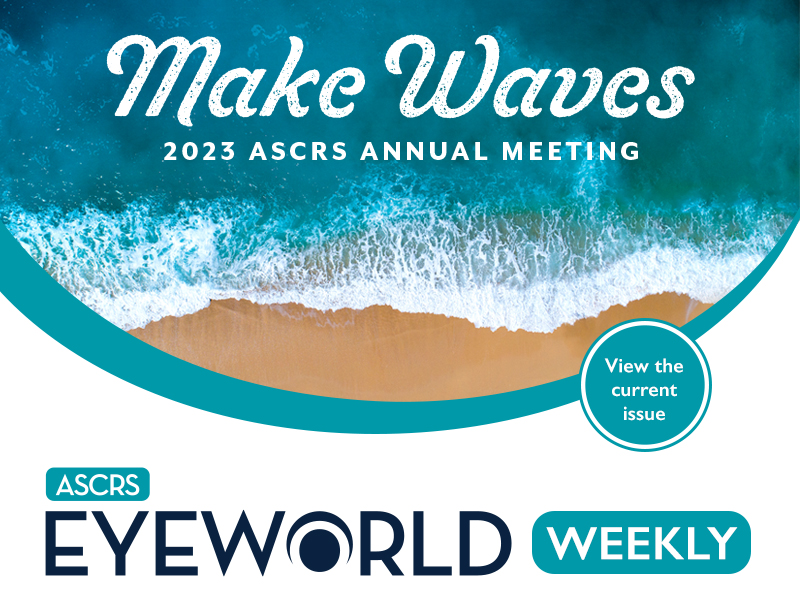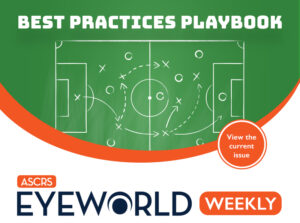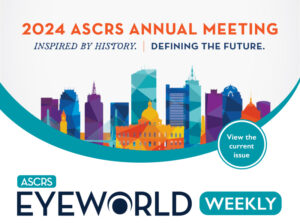
- FDA approves new monofocal IOL
- Topline Phase 3 results for fixed-dose combination presbyopia drop
- Gene therapy trial produces positive Phase 1/2 data for Leber congenital amaurosis
- New data shows investigational compound protects endothelium for cataract patients undergoing Fuchs treatment
- ASCRS news and events
April 28, 2023 • Volume 29, Number 17
FDA approves new monofocal IOL
Zeiss Medical Technology announced FDA approval of its CT LUCIA 621P IOL. This IOL, according to the company’s press release, is aspheric, monofocal, and a single-piece C-loop, featuring the company’s patented Asphericity Concept, which it stated is “designed to compensate for a wide range of spherical aberrations and at the same time optimize visual outcomes in the event of potential decentration and lens misalignments.”
Topline Phase 3 results for fixed-dose combination presbyopia drop
Visus announced topline results from its pivotal Phase 3 clinical trial of BRIMOCHOL PF, an investigational preservative-free, fixed-dose combination carbachol and brimonidine, compared to carbachol and brimonidine monotherapies. According to the company’s press release, once-daily BRIMOCHOL PF showed a highly statistically significant improvement in near and distance binocular visual acuity compared to the monotherapies. The press release reported a clinically and statistically significant reduction in pupil size out to 10 hours. The treatment was well tolerated with no serious treatment-related adverse events.
Gene therapy trial produces positive Phase 1/2 data for Leber congenital amaurosis
Atsena Therapeutics announced that its ongoing Phase 1/2 clinical trial of ATSN-101, a gene therapy for GUCY2D-associated Leber congenital amaurosis, achieved clinically meaningful improvements in vision. This was accomplished at the highest dose with no drug-related serious adverse events 6 months after treatment. The trial included 15 patients, three of whom were pediatric, who received ATSN-101 via subretinal delivery according to different cohorts that were given ascending doses. According to the press release, two patients in the trial achieved a BCVA improvement greater than 0.3 logMAR and four of five high-dose patients who had a mobility test achieved the maximum score of 6 (or a 2 or more level improvement) compared to baseline or compared to their fellow untreated eye.
New data shows investigational compound protects endothelium for cataract patients undergoing Fuchs treatment
Trefoil Therapeutics announced data from a Phase 2 study that described the use of TTHX1114, an investigational compound being developed for corneal disease treatment, as a protectant for corneal endothelium during cataract surgery in patients who have Fuchs and were also having Descemet’s-only stripping (DSO). According to the data, use of TTHX1114 produced a dose-dependent response in resolving corneal edema and improvement in BCVA after cataract surgery. According to the company’s press release, the proportion of patients who saw complete resolution of cornea edema at 28 days postop in the high-dose groups of TTHX1114 was similar among patients who had DSO alone vs. DSO plus cataract surgery. The company stated that visual outcomes of patients having DSO was not adversely affected by concurrent cataract surgery. The company also announced in its press release the completion of its Phase 1 epithelial study, evaluating the safety of topical TTHX1114 to reduce duration and impact of corneal epithelial defects.
ASCRS news and events
- ASCRS Annual Meeting: The ASCRS Annual Meeting, May 5–8, in San Diego, California, begins next week. There’s still time to register online and onsite!
- Eyecelerator: Registration is open for Eyecelerator @ ASCRS 2023. The innovation conference from ASCRS and the American Academy of Ophthalmology will be held on May 4 in San Diego, California. Join investors, industry leaders, and ophthalmologists at this showcase of companies, technology, and other exciting innovation topics in ophthalmology.
- Ophthalmology Quicksand Chronicles—Eureka Moments: The second episode of Season 3 from this ASCRS podcast, hosted by Nicole Fram, MD, and Elizabeth Yeu, MD, is live. Find it here.
Research highlights
- The outcomes of IOL exchange in the setting of an open posterior capsule vs. a closed posterior capsule were assessed in a nonrandomized, retrospective chart review published in the Journal of Cataract & Refractive Surgery. According to the paper, the IOL exchanges included in the analysis were being conducted to relieve optical symptoms (exchange due to IOL malposition or dislocation were excluded, as were eyes with uncontrolled glaucoma, inflammation, and visual potential worse than 20/40). The analysis included 90 eyes of 75 patients; 38 eyes had an open posterior capsule and 52 a closed posterior capsule. Three eyes in the open group and two in the closed group had worsening IOP control, one eye in the open group had chronic inflammation, two in the open group and two in the closed group had cystoid macular edema, and one in the closed group experienced a retinal tear. The authors concluded that “in the hands of an experienced surgeon” there were not statistically or clinically significant differences in postop complications between the two groups.
- Tolerance to residual astigmatism and visual performance was compared between two IOLs—the monofocal TECNIS ZCB00 (Johnson & Johnson Vision) and the monofocal with some EDOF capabilities TECNIS Eyhance DIB00 (Johnson & Johnson Vision). The study published in the Journal of Refractive Surgery was prospective and observational, including patients who underwent routine cataract surgery. According to the paper, eyes that received the Eyhance showed more astigmatic tolerance and were more likely to have 20/40 or greater visual acuity, even with up to 2 D of induced against-the-rule astigmatism and oblique astigmatism. More specifically, eyes that received Eyhance had better visual acuity of 1.3 lines at 2 D of against-the-rule astigmatic defocus and 1 line better at 1.5 D of oblique astigmatic defocus. The authors noted that distance visual acuity was comparable, but near and intermediate visual acuities were better in the Eyhance group.
Product news
- Bausch + Lomb announced the launch of StableVisc cohesive ophthalmic viscosurgical device (OVD) and TotalVisc Viscoelastic System, the latter of which includes StableVisc and ClearVisc (a dispersive OVD).
This issue of EyeWorld Weekly was edited by Stacy Jablonski, Liz Hillman, and Ellen Stodola.
EyeWorld Weekly (ISSN 1089-0319), a digital publication of the American Society of Cataract and Refractive Surgery (ASCRS), is published every Friday, distributed by email, and posted live on Friday.
Medical Editors: Sumit “Sam” Garg, MD, Chief Medical Editor, Mitchell Weikert, MD, Cataract Editor, Karolinne Rocha, MD, PhD, Refractive Editor, Julie Schallhorn, MD, Cornea Editor, Manjool Shah, MD, Glaucoma Editor
For sponsorship opportunities or membership information, contact: ASCRS • 12587 Fair Lakes Circle • Suite 348 • Fairfax, VA 22033 • Phone: 703-591-2220 • Fax: 703-591-0614 • Email: ascrs@ascrs.org
Mention of products or services in EyeWorld Weekly does not constitute an endorsement by ASCRS.
Click here to view our Legal Notice.
Copyright 2023, EyeWorld News Service. All rights reserved.



